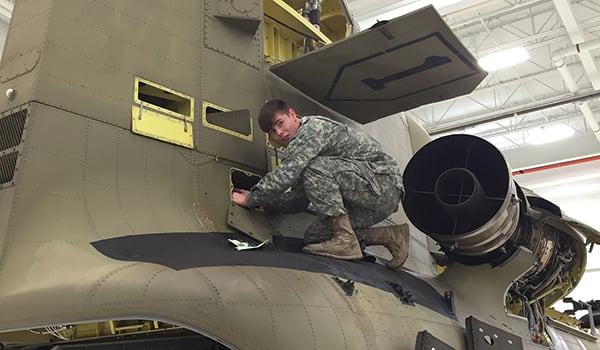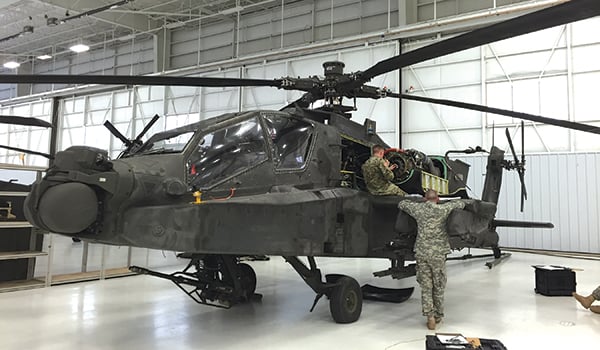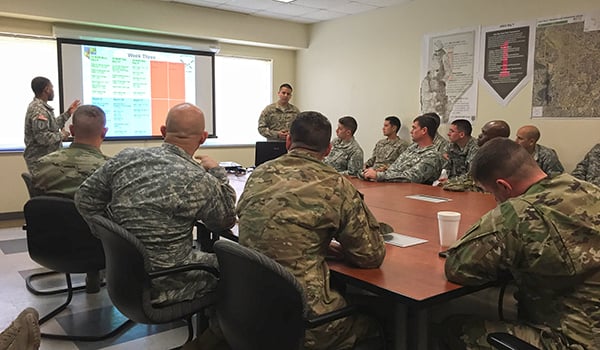
By MAJ Cristian Robbins, CPT Benjamin Wynia, and 1LT Andrew Petefish: Rebuilding a $38 million dollar helicopter for combat is a matter of life and death, and the Army entrusts the task to a 23-year-old corporal. This is not a new symptom of budget cuts or bureaucracy run amok. This is how the Army develops new leaders of character. In early December, CPL Nolan Tiller presented the 200-hour Phase Maintenance Inspection (PMI) brief for a CH-47F aircraft. His phase brief identified the problems with the helicopter and outlined a plan to systematically rebuild it to be fully mission capable. The audience for CPL Tiller’s presentation included his team of 25 soldiers and platoon leadership, the Company B commander, the 601st Aviation Support Battalion (ASB) commander, and the deputy commanding general for support of the 1st Infantry Division. CPL Tiller’s brief established the conditions and standards for the phase maintenance inspection on a CH-47F using the Problem, Plan, People, Parts, Time, Tools, and Training (P4T3) format found in Technical Circular 3-04.7 Army Aviation Maintenance.

SPC Nicholas Sternson performs maintenance in the aft pylon of a CH-47F during a 200 Hour Phase Maintenance Inspection. / ALL PHOTOS BY CPT BENJAMIN WYNIA, B/601ST ASB
The phase maintenance inspection brief is designed to mirror the principles of mission command by incorporating clear command intent and creating a shared understanding. At the end of the brief, the phase team and senior leaders sign a contract, signifying mutual trust and commitment to the mission, building a cohesive team. CPL Tiller’s successful phase maintenance inspection brief demonstrates how a unit can complete scheduled maintenance inspections while developing junior noncommissioned officers (NCOs) to serve in positions of greater responsibility.
Creating Shared Understanding and Setting Expectations
The objective of phase maintenance inspections is to return a fully mission capable aircraft to the customer on time. There are multiple controllable and uncontrollable factors which can impact whether maintenance is completed on time. Maintenance is often delayed while phase teams wait for specialized parts or tools to complete tasks. The date that the aircraft is delivered for phase maintenance may also change at the last minute, reducing predictability. Finally, many significant aircraft faults are not uncovered until the inspection begins, forcing maintenance teams to react on short notice. All these factors are things the phase team leader typically cannot control.
The phase team leader must plan in flexibility for uncontrollable delays and select a target completion date. Technical Circular 3-04.7 does not mandate a standard completion time for scheduled phase maintenance inspections. However, the PMI checklist for each type of aircraft annotates the man hours required for each task. For example, a UH-60L, per TM1-1520-237-PMI, requires approximately 97 man hours per Soldier on a phase team for a PMI-1 and approximately 127 man hours per Soldier for a PMI-2. In units that use a 0900-1700 workday, with an hour and a half break for lunch, a PMI-1 requires 15 work days and a PMI-2 requires 20 work days. This timeline does not include special inspections, calendar inspections, cleaning and lubrication requirements, DA Form 2408-18 inspections, aviation safety action messages (ASAMs), or aviation maintenance action messages (AMAMs). These additional inspections often double the amount of time required to complete the maintenance.

SGTs Justin Mitchell and Anthony Zacarias, 15T (Black Hawk) phase team leaders, conduct a phase maintenance inspection brief for an upcoming PMI-2 for a UH-60M helicopter.
Phase team leadership and time management is the most important controllable factor impacting timely completion of aircraft maintenance. Phase team leaders must provide motivation, schedule predictability, and efficient workload distribution, while shielding their workers from distractions and non-essential tasks. The PMI brief is essential to this management process. Senior leaders use the phase brief to bring the team together, empower the team leader, discuss the maintenance objectives, and create a sense of shared purpose and understanding which improves motivation. The phase brief also outlines a day by day schedule, team configuration, and workload distribution, ensuring that each soldier understands their individual role. This is pivotal to creating shared understanding and building trust at all levels. The phase schedule presented in the PMI brief also includes planned buffers to address delays posed by uncontrollable factors like parts availability or unplanned aircraft faults. These facets of the phase brief combine to offer purpose, direction, and motivation thereby significantly improving the management, teamwork, and efficiency of aviation maintenance.
Phase Maintenance Inspection Briefs as a Junior Leader Development Tool
The Phase Maintenance Inspection brief can also be utilized as a leader development tool. The phase team leader must utilize critical thinking and interpersonal skills to develop an inspection schedule and coordinate with all entities needed for the inspection (Production Control, Quality Control, etc.). The phase team leader must interface with each stakeholder to develop a coherent and feasible phase maintenance schedule and then convey this to his team and unit leaders in the PMI brief. This type of planning and higher level thinking provides that phase team leader with invaluable experience and prepares them for greater levels of responsibility in the future.

SGTs Justin Mitchell and Anthony Zacarias, 15T (Black Hawk) phase team leaders, conduct a phase maintenance inspection brief for an upcoming PMI-2 for a UH-60M helicopter.
The junior leader serving as a phase team leader has an opportunity to brief senior NCOs, senior warrant officers and maintenance test pilots, and company and field grade officers. The senior leadership has an opportunity to provide feedback and input on the plan along with feedback for the junior leader on their performance in preparing and executing a PMI brief. Delivering the phase brief teaches junior leaders to communicate confidently to large audiences and soldiers of all ranks. The feedback provided on the plan will help optimize the phase maintenance inspection and the feedback on the performance of the junior leader during the brief will help that person continue to improve and develop. At the completion of the brief, senior leadership will have trained, certified, and developed the phase team leader and know that the conditions are set for the execution of a phase maintenance inspection.
As demonstrated by CPL Tiller, PMI briefs when conducted properly are an important tool in junior leader development and creating shared understanding and predictability for members of a phase team. It is an opportunity for junior leaders to brief their leadership and receive valuable feedback to help them as they develop. Senior leaders providing the feedback are able to certify their junior leaders and provide input to the phase maintenance inspection plan. Units utilizing the phase maintenance inspection brief prior to the start of any inspection set themselves for a successful inspection and greatly enhance their leader development program.
MAJ Cristian Robbins is the commander, CPT Benjamin Wynia the executive officer, and 1LT Andrew Petefish the maintenance platoon leader for Company B, 601st Aviation Support Battalion, Combat Aviation Brigade, 1st Infantry Division at Fort Riley, KS.










